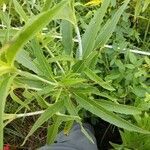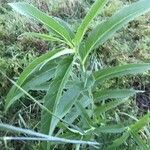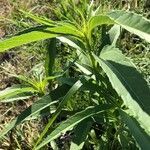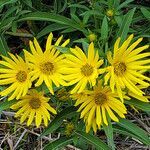Coarsely fibrous-rooted, rhizomatous perennial; stems 1–4 m, strigose in the infl, otherwise glabrous and often glaucous; lvs lanceolate, 10–20 × 1.5–4 cm (or the lower larger), acuminate, tapering to an often winged petiole 1–4 cm, sharply toothed to sometimes subentire, strigose on both sides, or more hirtellous or puberulent especially on the paler lower surface, usually slightly trinerved at base, the middle and upper commonly alternate; disk yellow, 1.5–2.5 cm wide; invol bracts lance-linear, loose, attenuate, surpassing the disk, ± ciliate, at least near the base, and sometimes short-hairy on the back; rays 10–20, 2–4.5 cm; 2n=34. Bottomlands, damp prairies, and other moist places; Me. to Minn., s. to Ga. and Tex., perhaps only intr. e. of O. July–Oct. A. hybrid with H. salicifolius has been called H. ×kellermanii Britton.
A herb.








